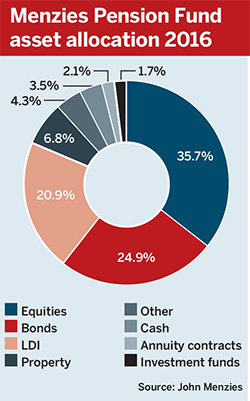A memorandum of understanding has been signed by John Menzies and trustees of its pension scheme as it has closed the scheme and plans to begin a sectionalisation process, but experts have highlighted that this sort of agreement is rarely legally binding.
Scheme sectionalisation is often implemented to facilitate corporate transactions and has been used by a number of large companies in the past year, including National Grid and BAE Systems.
The devil is often in the detail – it is always possible to have a MoU where both parties think they are agreeing the same thing, but the details may be very different
Rosalind Connor, ARC Pensions Law
At the end of March, Edinburgh-based John Menzies announced that it was in discussions with DX Group regarding the potential combination of John Menzies’ Distribution division with DX.
The announcement came following discussions related to possible pension changes with trustees last year, as investor pressure prompted the aviation and logistics company to start considering whether to split its two businesses.
Scheme closure
At the end of last month, the company also announced the closure to future accrual for the active members of the scheme. Furthermore, the company has signed a memorandum of understanding with its pension fund’s trustees to create a section of the scheme to be supported by the Menzies Distribution business.
“The decision to close the scheme to future accrual was taken as it is the company’s long-term aim to harmonise pension benefits across its UK workforce,” said a spokesperson for John Menzies.
The consultation process for the scheme closure lasted from the end of October 2016 to the end of March this year.
In order to reach the point at which the memorandum could be signed, the spokesperson said the company and trustees received appropriate legal, actuarial and covenant valuation advice.
The memorandum “details the agreement between the company and the trustees of the process and timetable to sectionalise the scheme by the summer”, the spokesperson explained. “There will be one trust, one set of trustees, but two independent sections.”
Building trust
A memorandum of understanding is usually a non-contractual agreement that the parties intend to do something, said Rosalind Connor, partner at law firm Arc Pensions Law.
“They are used increasingly in pension scheme situations as trustees and employers build relationships and trust, but know that actually the things they propose to do will take a long time,” Connor explained.

She noted that generally, the memorandum allows the trustees and employer to spend the time and costs working towards a goal with the confidence that they agree on what they want to do. In this case, the goal is sectionalisation.
The agreement gives the parties certainty, “without everything having to be finalised”, said Connor. However, “technically it is rarely legally binding, so in fact either party could back out”.
In practice, this would have the potential to damage the relationship between the trustees and the employer, “but it is always possible”, she said.
Read the small print
Connor also highlighted that “the devil is often in the detail – it is always possible to have a [memorandum] where both parties think they are agreeing the same thing, but the details may be very different”.
John Menzies considers change as activists increase split pressure
Aviation services and distribution provider John Menzies is in talks with trustees over possible changes to its pension scheme, as the group considers splitting its two businesses under mounting pressure from activist investors.
Faith Dickson, partner at law firm Sackers, said the firm was seeing more memorandums used by pension funds. But she agreed with Connor that they are not generally legally binding.
However, a memorandum can make discussions and agreements feel “a bit more concrete” and can give assurance to trustees when it comes to corporate restructuring, said Dickson.
A memorandum of understanding is also sometimes seen by corporates as a control mechanism, she said, and is quite often used to give the company certainty about how the trustees are going to behave in the future.
For a company, having signed a memorandum is helpful when making a case to investors, banks and possible buyers, as it can say to them that “we think we can deliver this solution because we think that the trustees are on board with it”, Dickson said.














